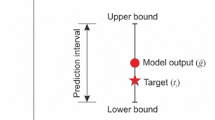Abstract
Based on time series analysis, total accumulative displacement of landslide is divided into the trend component displacement and the periodic component displacement according to the response relation between dynamic changes of landslide displacement and inducing factors. In this paper, a novel neural network technique called the ensemble of extreme learning machine (E-ELM) is proposed to investigate the interactions of different inducing factors affecting the evolution of landslide. Trend component displacement and periodic component displacement are forecasted respectively, then total predictive displacement is obtained by adding the calculated predictive displacement value of each sub. A case study of Baishuihe landslide in the Three Gorges reservoir area is presented to illustrate the capability and merit of our model.
Access this chapter
Tax calculation will be finalised at checkout
Purchases are for personal use only
Preview
Unable to display preview. Download preview PDF.
Similar content being viewed by others
References
Kawabata, D., Bandibas, J.: Landslide susceptibility mapping using geological data, a DEM from ASTER images and an Artificial Neural Network (ANN). Geomorphology 113, 97–109 (2009)
Cubito, A., Ferrara, V., Pappalardo, G.: Landslide hazard in the Nebrodi Mountains (Northeastern Sicily). Geomorphology 66, 359–372 (2005)
Du, J., Yin, K.L., Chai, B.: Study of displacement prediction model of landslide based on respones analysis of inducing factors. Chinese Journal of Rock Mechanics and Engineering 28, 1783–1789 (2009)
Wang, J.F.: Quantitative prediction of landslide using S-curve. Chinese Journal of Rock Mechanics and Engineering 14, 1–8 (2003)
Chen, H.Q., Zeng, Z.G.: Deformation prediction of landslide based on genetic-simulated annealing algorithm and BP neural network. In: 4th International Workshop on Advanced Computational Intelligence, pp. 675–679 (2011)
Nefeslioglu, H.A., Gokceoglu, C., Sonmez, H.: An assessment on the use of logistic regression and artificial neural networks with different sampling strategies for the preparation of landslide susceptibility maps. Eng. Geol. 97, 171–191 (2008)
Amro, E.J., John, M.: A new error criterion for posterior probability estimation with neural nets. In: Proceedings of Iteration Joint Conference on Neural Networks, pp. 185–192 (1990)
Harris, D., Yann, L.C.: Improving generalization performance using double backpropagation. IEEE Trans. Neural Networks 3, 991–997 (1992)
Huang, G.B., Zhu, Q.Y., Siew, C.K.: Extreme learning machine: Theory and applications. Neurocomput. 70, 489–501 (2006)
Zhu, Q.Y., Qin, A.K., Suganthan, P.N., Huang, G.B.: Evolutionary extreme learning machine. Pattern Recogn. 38, 1759–1763 (2005)
Huang, G.B.: Learning capability and storage capacity of two-hidden-layer feedforward networks. IEEE Trans. Neural Networks 14, 274–281 (2003)
Huang, G.B., Haroon, A.B.: Upper bounds on the number of hidden neurons in feedforward networks with arbitrary bounded nonlinear activation functions. IEEE Trans. Neural Networks 9, 224–229 (1998)
Huang, G.B., Chen, L., Siew, C.K.: Universal approximation using incremental constructive feedforward networks with random hidden nodes. IEEE Trans. Neural Networks 17, 879–892 (2006)
Tamura, S., Tateishi, M.: Capabilities of a four-layered feedforward neural network: four layers versus three. IEEE Trans. Neural Networks 8, 251–255 (1997)
Sun, Z.L., Choi, T.M., Au, K.F., Yu, Y.: Sales forecasting using extreme learning machine with applications in fashion retailing. Decis. Support Syst. 46, 411–419 (2008)
Lan, Y., Chai, Y., Huang, G.B.: Ensemble of online sequential extreme learning machine. Neurocomput. 72, 3391–3395 (2009)
Hornik, K.: Approximation capabilities of multilayer feedforward networks. Neural Networks 4, 251–257 (1991)
Author information
Authors and Affiliations
Editor information
Editors and Affiliations
Rights and permissions
Copyright information
© 2012 Springer-Verlag Berlin Heidelberg
About this paper
Cite this paper
Lian, C., Zeng, Z., Yao, W., Tang, H. (2012). Displacement Prediction Model of Landslide Based on Ensemble of Extreme Learning Machine. In: Huang, T., Zeng, Z., Li, C., Leung, C.S. (eds) Neural Information Processing. ICONIP 2012. Lecture Notes in Computer Science, vol 7666. Springer, Berlin, Heidelberg. https://doi.org/10.1007/978-3-642-34478-7_30
Download citation
DOI: https://doi.org/10.1007/978-3-642-34478-7_30
Publisher Name: Springer, Berlin, Heidelberg
Print ISBN: 978-3-642-34477-0
Online ISBN: 978-3-642-34478-7
eBook Packages: Computer ScienceComputer Science (R0)




